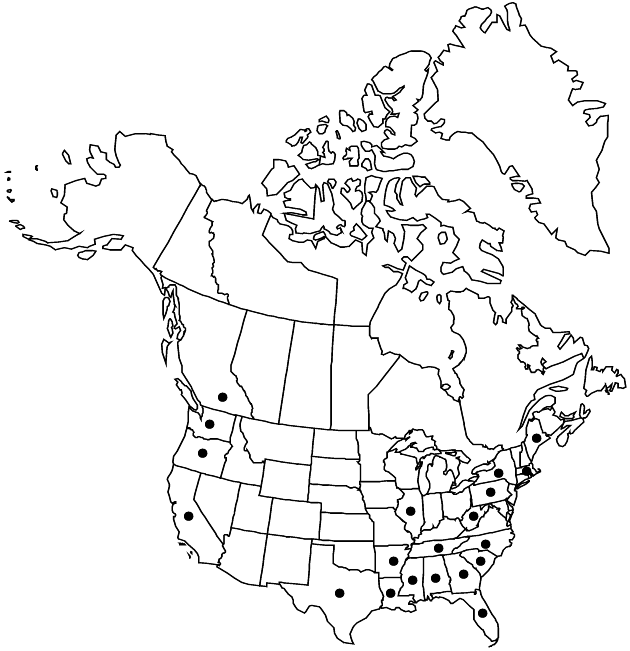Difference between revisions of "Hypochaeris glabra"
Sp. Pl. 2: 811. 1753.
imported>Volume Importer |
GeoffLevin (talk | contribs) m (Added "|introduced=true" after distribution list in Taxon area) |
||
| (3 intermediate revisions by the same user not shown) | |||
| Line 27: | Line 27: | ||
|habitat=Grassy slopes, sage scrub, pine-hardwood forest, disturbed areas, roadsides, commonly in sandy soil | |habitat=Grassy slopes, sage scrub, pine-hardwood forest, disturbed areas, roadsides, commonly in sandy soil | ||
|elevation=100–1300 m | |elevation=100–1300 m | ||
| − | |distribution= | + | |distribution=B.C.;Ala.;Ark.;Calif.;Fla.;Ga.;Ill.;La.;Maine;Mass.;Miss.;N.Y.;N.C.;Oreg.;Pa.;S.C.;Tenn.;Tex.;Wash.;W.Va.;Europe. |
| + | |introduced=true | ||
|discussion=<p><i>Hypochaeris glabra</i> is usually distinguishable by its annual habit and relatively small size, slender and shallow roots, fine stems, often glabrous leaves, and beakless, truncate outer cypselae. Occasional specimens are larger and have induments characteristics of <i>H. radicata</i>; they can be distinguished by the dimorphic cypselae.</p> | |discussion=<p><i>Hypochaeris glabra</i> is usually distinguishable by its annual habit and relatively small size, slender and shallow roots, fine stems, often glabrous leaves, and beakless, truncate outer cypselae. Occasional specimens are larger and have induments characteristics of <i>H. radicata</i>; they can be distinguished by the dimorphic cypselae.</p> | ||
|tables= | |tables= | ||
| Line 46: | Line 47: | ||
|habitat=Grassy slopes, sage scrub, pine-hardwood forest, disturbed areas, roadsides, commonly in sandy soil | |habitat=Grassy slopes, sage scrub, pine-hardwood forest, disturbed areas, roadsides, commonly in sandy soil | ||
|elevation=100–1300 m | |elevation=100–1300 m | ||
| − | |distribution= | + | |distribution=B.C.;Ala.;Ark.;Calif.;Fla.;Ga.;Ill.;La.;Maine;Mass.;Miss.;N.Y.;N.C.;Oreg.;Pa.;S.C.;Tenn.;Tex.;Wash.;W.Va.;Europe. |
| + | |introduced=true | ||
|reference=None | |reference=None | ||
|publication title=Sp. Pl. | |publication title=Sp. Pl. | ||
Latest revision as of 15:23, 26 September 2022
Annuals, 10–50 cm; taproots slender, vertical; caudices small, ± herbaceous. Stems (1–30), sparingly branched at midstem or distally (lateral branches often short, minutely bracteate or naked), glabrous. Leaves usually all basal; blades oblanceolate to oblong, 20–110 × 5–30 mm, margins nearly entire to dentate or pinnatifid, faces usually glabrous or glabrate, sometimes hirsute on veins. Heads borne singly or 2–3 in loose, cymiform arrays (terminating branches, not showy). Involucres narrowly campanulate, 8–16 × (3–)5–20 mm. Phyllaries 18–20, lanceolate, 3–18 mm, unequal, margins scarious, faces glabrous (apices brownish or reddish, sometimes ciliate). Florets 20–40; corollas white to yellowish, 5–8 mm, ± equaling phyllaries at flowering. Cypselae dimorphic, outer cylindric, stout, truncate, inner fusiform, slender, beaked; bodies dark brown, 10-nerved, 8–10 mm, beaks 3–4 mm; pappi of tawny bristles in 2 series, outer barbellate, shorter than plumose inner, longest 9–10 mm. 2n = 8, 10, 12.
Phenology: Flowering Feb–Jun(–Dec).
Habitat: Grassy slopes, sage scrub, pine-hardwood forest, disturbed areas, roadsides, commonly in sandy soil
Elevation: 100–1300 m
Distribution

Introduced; B.C., Ala., Ark., Calif., Fla., Ga., Ill., La., Maine, Mass., Miss., N.Y., N.C., Oreg., Pa., S.C., Tenn., Tex., Wash., W.Va., Europe.
Discussion
Hypochaeris glabra is usually distinguishable by its annual habit and relatively small size, slender and shallow roots, fine stems, often glabrous leaves, and beakless, truncate outer cypselae. Occasional specimens are larger and have induments characteristics of H. radicata; they can be distinguished by the dimorphic cypselae.
Selected References
None.